 "A fiery stream issued and came forth from before him: thousand thousands ministered unto him, and ten thousand times ten thousand stood before him: the judgment was set, and the books were opened."
Daniel 7:10
"A fiery stream issued and came forth from before him: thousand thousands ministered unto him, and ten thousand times ten thousand stood before him: the judgment was set, and the books were opened."
Daniel 7:10
Lesson #9
A VIEW OF THE JUDGMENT
The Bible speaks of a judgment in which men shall be called to give an account to God for their deeds. Christ warned His hearers that for "every idle word that men shall speak, they shall give account thereof in the day of judgment" (Matthew 12:36). Paul preached the judgment before Felix (Acts 24:25), and Daniel in vision saw the judgment in session (Daniel 7:9-10). A subject of so great importance, which involves every living being, deserves the closest study. The prophecy of Daniel that is presented in this lesson points to the exact time for the beginning of the judgment. Let us now open our Bibles to Daniel, chapter eight, and observe that the prophet is given a clear-cut view of the period in history when the judgment convenes in heaven.

THE VISION OF DANIEL 8
We are now back with Daniel in the palace of an ancient empire where he received a dramatic vision from God. A few questions will help us get our bearings. Remember, please, these questions will not help you much unless you have read Daniel eight and nine!
1. Who is represented by the ram and its two horns?
Daniel 8:20 -"The ram which thou sawest having two horns are the kings of Media and Persia."
Little explanation is needed. The Bible is perfectly plain. One of the ram's horns was higher than the other, indicating that one of the powers of this dual monarchy, Medo-Persia, was to be stronger than the other. Daniel 8 adds the point that the higher came up last. "The Medes were at first the leading people" (Phillip V. Meyers, General History, p. 59 [Daniel 5:30-31; Jeremiah 51:11]). Later the Persians were in the ascendancy. Alexander the Great, of Grecia, about 200 years after Babylon's fall, overcame the Persians under Darius III, at the battle of Arbela in 331 B.C.
 2. Who is represented by the goat?
2. Who is represented by the goat?
Daniel 8:21-"The rough goat is the king of Grecia."
The goat represents Grecia, or Greece. This is clearly stated. The leopard, with four wings, in Daniel 7, indicated swiftness. The goat "touched not the ground," so rapid was his movement. Both these symbols for Grecia are fitting. Medo-Persia was to become "great" Grecia was to be "very great."
3. Who is symbolized by the great horn between his eyes?
Daniel 8:21-"The great horn that is between his eyes is the first king."
Alexander the Great, the first king, was to be broken when Grecia was strong. Alexander led Grecia to world leadership, then died of a fever following a drunken spree, at the age of thirty-two, in 323 B.C. Grecia was strong when Alexander was at the height of its glorious conquests.

4. What do the four horns of the goat represent?
Daniel 8:22- "Now that being broken, whereas four stood up for it, four kingdoms shall stand up out of the nation, but not in his power."
The four horns represent the four divisions of Alexander's realm. The historian, Rawlinson, says, "A quadripartite [fourfold] division of Alexander's dominion was recognized." This took place twenty-two years after Alexander's death; when, after the Battle of Ipsus, his warring generals divided the kingdom into four parts-east, west, north, south "toward the four winds of heaven." The four horns correspond to the four heads of the leopard of Daniel 7.
The accompanying chart and explanation will clarify the events which are set forth in the prophecies of the 70 weeks and the 2300 days. The Bible clearly shows that, often in prophecy, God uses a day to represent a year (Numbers 14:34; Ezekiel 4:6). This prophecy, in Daniel 9, demonstrates the principle and sets the seal to the whole prophecy of the 2300 years. The decree to restore and rebuild Jerusalem was completed when Artaxerxes restored civil government to the Jewish nation in 457 B.C. In AD. 27, 483 years later, Christ was baptized in the Jordan River and was anointed by the Holy Spirit descending upon Him in the form of a dove. In AD. 31, three and a half years later, "in the midst of the week," He was crucified. The stoning of Stephen marked the final rejection of Christ's mission by the Jewish nation. Henceforth the message of salvation was to be preached to the Gentiles. These historical events definitely establish the 2300-day prophecy and fix the termination of this long period in the year 1844.
5. What empire is represented by the little horn that grew out of one of the four winds?
Daniel 8:23-"In the latter time of their kingdom, when transgressors are come to the full, a king of fierce countenance, and under standing dark sentences, shall stand up."
Bible prophecy did not name specifically the successor of the Grecian kingdom. Daniel's previous prophecies (Daniel 2 and 6) follow the pattern of the four world empires seen in history-Babylon, Medo-Persia, Greece, and Rome. The prophecy of Daniel 8 begins with the second, Medo-Persia, and presents three empires. This last kingdom was the one that was to "stand up against the Prince of princes" (Daniel 8:25). Jesus Christ was that prince, and the Roman power put Him to death. So the little horn was Rome. The little horn came forth from one of the four winds. The Romans defeated the Macedonians in 168 B.C. This was the western division of Greece. From this beginning, Rome went on to conquer all. Pagan Rome became "exceeding great. And since pagan Rome was followed by papal Rome, it can be said that papal Rome also became "exceeding great" (see the lesson on a prophetic study of Daniel 7 and the papacy). Finally all earthly powers will be "broken without hand," at the second coming of Christ, which is represented in Daniel 2 as the "stone . . cut out of the mountain without hands" (Daniel 2:45) and destroys the kingdoms of earth.
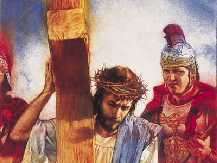

6. What long time period is introduced into the prophecy at this point?
Daniel 8:14-"And He said unto me, unto two thousand and three hundred days; then shall the Sanctuary be cleansed."
7. To what period of earth's history does the vision point?
Daniel 8: 17-"So he came near where I stood: and when he came, I was afraid, and fell upon my face: but he said unto me, Understand, 0 son of man: for at the time of the end shall be the vision."
A part of this prophecy is to reach to the "time of the end." Since we are living in that time, we should prayerfully study to know the meaning of that portion of the prophecy which applies in our day.
8. What happened to Daniel when the angel had proceeded thus far in his explanation of the vision?
Daniel 8:26-27-"The vision of the evening and the morning which was told is true: wherefore shut thou up the vision; for it shall be for many days. And I Daniel fainted, and was sick certain days."
Daniel fainted and was sick as he saw the host of God and the Sanctuary trodden underfoot (Daniel 8:13, 27). He did not fully understand how this would take place, nor the meaning of the long period of 2300 days. The words rang in his ears, "Unto two thousand and three hundred days: then shall the Sanctuary be cleansed." What could they mean? Daniel was deeply concerned about the 2300 days, but no explanation had been given to him.

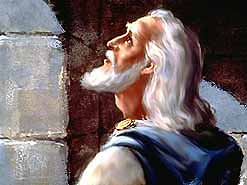 2 - THE VISION OF DANIEL 9
2 - THE VISION OF DANIEL 9
As chapter nine opens, we find Daniel still in distress over the unexplained portion of the vision, the 2300 days. Let us notice what happened. First of all: Daniel prayed for light on the Sanctuary.
Daniel 9:1-4- "In the first year of Darius the son of Ahasuerus, of the seed of the Medes, which was made king over the realm of the Chaldeans; in the first year of his reign I Daniel understood by books the number of the years, whereof the word of the Lord came to Jeremiah the prophet, that he would accomplish seventy years in the desolations of Jerusalem. And 1 set my face unto the Lord God, to seek by prayer and supplication, with fasting, and sackcloth, and ashes: and I prayed unto the Lord my God."
Daniel 9:17-"Now therefore, 0 our God, hear the prayer of Thy servant, and His supplications, and cause Thy face to shine upon Thy Sanctuary that is desolate, for the Lord's sake."
He began to study the prophecies diligently (Daniel 9:1-2). He prayed earnestly and confessed his sins and the sins of his people (Daniel 9:4-5, 20). This is a good way to get light from God.
Then, Gabriel came from God to give him understanding on the 2300 days.

Daniel 9:21-22- "Whiles I was speaking in prayer, even the man Gabriel, whom I had seen in the vision at the beginning, being caused to fly swiftly, touched me about the time of the evening oblation. And he informed me, and talked with me, and said, 0 Daniel, I am now come forth to give thee skill and understanding."
Gabriel introduced his explanation as follows:
Daniel 9:23 - "I am come to shew thee; for thou art greatly beloved: therefore understand the matter, and consider the vision."
The angel Gabriel (Daniel 9:21) came in order that Daniel might "understand the matter, and consider the vision" (Daniel 9:21-23). The only vision under consideration was the vision of Daniel 8. And the unexplained portion of that vision was the 2300 days and the Sanctuary. This was the part of the prophecy that Gabriel came to unfold to the prophet. He called Daniel's attention to the time element which had been left unexplained. "Seventy weeks are determined upon thy people," he said (Daniel 9:24).
Please turn now to your Bible and read again Daniel 9:24-27. Remember that the 70 weeks and the 2,300 days, or years, are associated. Remember, too, that, in prophecy, a day stands for a year (Numbers 14:34; Ezekiel 4:6).
Note the following seven points based on Daniel 9:24-27. Read these verses carefully.
1. Seventy weeks of seven days each would be 490 days, or literal years.
2. The 490 years are "determined," or cut off, especially for the Jews (Daniel 9:24). They are cut off from the 2,300 years, leaving 1,810 years.
3. The period was to begin with the date the Persians gave command to restore Jerusalem. This was 457 B.C. (Daniel 9:25; Ezra 7:11-26). The Babylonians had conquered the Jews. The Persians were to restore Jerusalem. God raised up Cyrus to perform His work (Isaiah 44:28).
4. The first 7 weeks (7 x 7 = 49 years) were for the rebuilding of Jerusalem.
5. The next 62 weeks (7 x 62 = 434 years) were to reach to the Messiah, or the Anointed One. Jesus was anointed at His baptism, A.D. 27 (Matthew 3: 13-17; Acts 10:38). When the clock of eternity struck the hour, Jesus was there on the bank of the Jordan River, to be baptized by John. "When the fulness of the time was come, God sent forth His Son" (Galatians 4:4).
6. The 70th week of 7 years would reach from A.D. 27 to AD. 34. In the midst
of this week, AD. 31, the Messiah was to be "cut off, but not for
Himself" (Daniel 9:26). This was fulfilled when Christ was
crucified. The Messiah was also to "cause the sacrifice and the oblation to
cease" (Daniel 9:27).
AD. 31, the Messiah was to be "cut off, but not for
Himself" (Daniel 9:26). This was fulfilled when Christ was
crucified. The Messiah was also to "cause the sacrifice and the oblation to
cease" (Daniel 9:27).
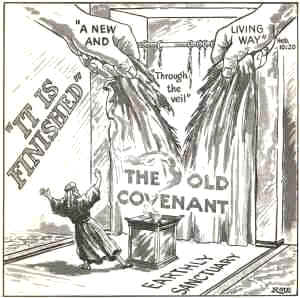 When Christ died on the cross, the veil of the
Temple of Jerusalem was torn from top to bottom by an unseen hand (Matthew 27:51).
A human hand would have torn it from the bottom to the top. God thus signified
that the sacrificial service of animals was over. The "Lamb of God"
had been slain.
When Christ died on the cross, the veil of the
Temple of Jerusalem was torn from top to bottom by an unseen hand (Matthew 27:51).
A human hand would have torn it from the bottom to the top. God thus signified
that the sacrificial service of animals was over. The "Lamb of God"
had been slain.
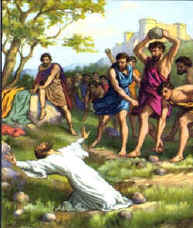 The remaining years of the 70th week, or the 490 years, reached
to AD. 34. Stephen was stoned to death by the Jews, and the great persecution of
the church at Jerusalem followed (Acts 7:59; 8: 1). The Jewish people as
a nation had rejected the Messiah, and now He left their house desolated. The
490 years allotted to the Jewish nation were finished.
The remaining years of the 70th week, or the 490 years, reached
to AD. 34. Stephen was stoned to death by the Jews, and the great persecution of
the church at Jerusalem followed (Acts 7:59; 8: 1). The Jewish people as
a nation had rejected the Messiah, and now He left their house desolated. The
490 years allotted to the Jewish nation were finished.
7. The 70 weeks, or 490 years, were part of the 2,300 years. Since the 490 years reach to AD. 34, the remaining 1,810 years of the 2,300 years would reach to 1844. If you have difficulty in figuring the date, 1844, and get 1843 instead (2300 minus 457 is 1843), just remember that it takes 457 full years before Christ and 1,843 full years after Christ to make 2,300. Since the decree went forth after a part of the year 457 B.C. had passed, the end of the 2,300 full years would fall after the close of A.D. 1843, well-over into the year of 1844.
At this time, the Sanctuary was to be cleansed. Many interpreters of prophecy living at that time thought the cleansing of the Sanctuary meant the end of the world. But the expression, "cleansing of the Sanctuary," had a different meaning. We shall seek to find the full truth of this important matter in the next lesson. But we can say this much now: The cleansing of the Sanctuary and the judgment of the world are closely related. When this subject is understood clearly, you will thrill with a new sense of love and respect for the great God who has revealed such mysteries to men.
The history of the Jews and their rejection of Christ is on record for our admonition. They did not understand the true nature, character, and purpose of Jesus' mission to the world nor the time of the visitation of their judgment. Yet the prophecies were clear on these points. Israel need not have rejected Christ and brought such calamities upon their nation. Let us with earnest purpose and prayer determine to know God's plan for us today, that we may cooperate with Him and accept fully the saving light of prophetic truth.
DANIELíS AMAZING PROPHECIES
The master prophecy of the Bible is given in Daniel 8. This chapter closely connects with Daniel 7 and 9, and should be studied with them.
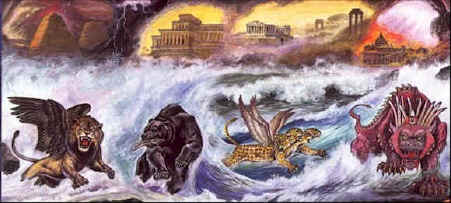
DANIEL 7 (written in 553-552 B.C.) reveals world history from Daniel's time down to the second advent of Christ. In vision, Daniel sees four world empires symbolized as beasts, followed by a little horn power (Dan 7:1-8, 15-21, 23-25). The Investigative Judgment then convenes in heaven (Dan 7:9-10,13, 22, 26). And, after that, history ends with the second advent of Christ (Dan 7:14,27-28).
 The animals in Daniel 7 parallel the parts of the metal image of Daniel 2.
The animals in Daniel 7 parallel the parts of the metal image of Daniel 2.
The lion in chapter 7 is Babylon (605-539 B.C.).
The bear is Medo-Persia (538-331 B.C.).
The leopard beast is Grecia (331-168 B.C.), at which time it becomes divided into four kingdoms which continue on until around 168 B.C.).
The terrible beast is Pagan Rome (168 B.C. to the 5th Century A.D., when it becomes broken into ten kingdoms).
The little horn is Papal Rome, which gained full power by A.D. 538, after uprooting three kingdoms (the Heruli, Vandals, and Ostrogoths).


DANIEL 8 is composed of two major parts. The first is an EVENT prophecy that closely parallels the prophecy of Daniel 7. This prophecy is about two beasts and a little horn that follows them (Dan 8:1-12, 20-25). The first beast, a ram, is Medo-Persia (538-331 B.C.), and the he-goat which struck it down was Grecia (334-168 B.C.). The "notable horn" was Alexander the Great who, before his death in 323, carved out the largest empire in history up to that time-in only ten years. When he was broken off in the prime of life, the empire divided into four sections. The little horn is Pagan Rome which, historians tell us, was taken over by Papal Rome. Much of Daniel 7 and 8 (7:8, 19-26, and 8:9-12, 23-25) is given to a concern over this power.
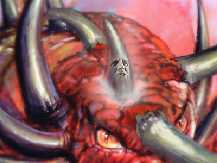
It would speak blasphemies (7:8, 20; 8:11), seek to kill God's people (7:21,25; 8:10, 24-25), cast down the truth (8:12,25), tear God's Sanctuary down from heaven (8:11), and even try to change the law of God (7:25). Revelation 13 (read verses 6-7, for example) deals with the same little horn power-the papacy.
But there is a second part to Daniel 8: This is a TIME prophecy (Dan 8:1314,26). The prophecy itself is given in Daniel 8:14. "Unto two thousand and three hundred days; then shall the sanctuary be cleansed." Careful reading of this chapter reveals that, while the angel Gabriel was told to explain the vision of Daniel 8 to the prophet (8:16), only the event prophecy was explained (8:17-25) while the time prophecy was only referred to (8:26). Daniel nearly fainted under the burden (8:27), and the prayer of Daniel 9 is the result.
DANIEL 9 begins with the prophet's prayer for guidance and help for his people (Dan 9:1-19). Gabriel, the one whom he had seen in his earlier vision (9:21), is then sent in answer to his prayer (9:20), in order to complete the explanation (9:22-23).
THE LONGEST PROPHECY BEGINS.
The 70 week prophecy (Dan 9:2427) is the first part of the 2300 day prophecy. Seventy weeks are "determined" ("cut off" in Hebrew-cut off from the larger 2300 day [year] prophecy) for the Jews. Therefore, the first part of the 2300 day prophecy of Daniel 8:14 is time allocated to the Jews, to conclude their probation as God's specially favored nation.
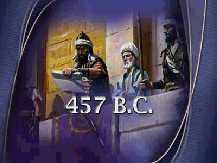
In Bible prophecy, a day equals a year (Num 14:34; Ezek 4:6). The decree of Artaxerxes, given in his seventh year as king, in 457 B.C. (Dan 9:25; Ezra 6:14; 7:6-8), restoring the Jewish government, begins this vast time prophecy of 2300 years. The first 70 weeks (Dan 9:24-27) of this prophecy, cut off or allotted to the Jews, equals 490 years. The walls of Jerusalem were rebuilt in 7 weeks, or 49 years (408 B.C.).
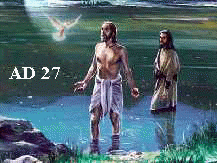 Another 62 weeks brings us to the anointing of Christ for
His mission in A.D. 27. Now 423 years are past; only 1 week remains of the 70.
In the midst of this week (Dan 9:26-27), A.D. 31, the Messiah is cut off,
crucified. A second half-week of 3112 years brings us to A.D. 34, when at the
stoning of Stephen the gospel is taken to the Gentiles.
Another 62 weeks brings us to the anointing of Christ for
His mission in A.D. 27. Now 423 years are past; only 1 week remains of the 70.
In the midst of this week (Dan 9:26-27), A.D. 31, the Messiah is cut off,
crucified. A second half-week of 3112 years brings us to A.D. 34, when at the
stoning of Stephen the gospel is taken to the Gentiles.
THE LONGEST PROPHECY ENDS.
In A.D. 34 the 70 weeks, or 490 years, is completed. There remains 410 years of this longest Bible prophecy, of Daniel 8:14, to be fulfilled. At its termination, in A.D. 1844, began the "cleansing of the sanctuary" predicted in this important passage of Daniel 8:14.
Jesus is our High Priest in the heavenly Sanctuary (the pattern of the earthly). In 1844, He began His final work in it, prior to His second advent to the earth for His people.